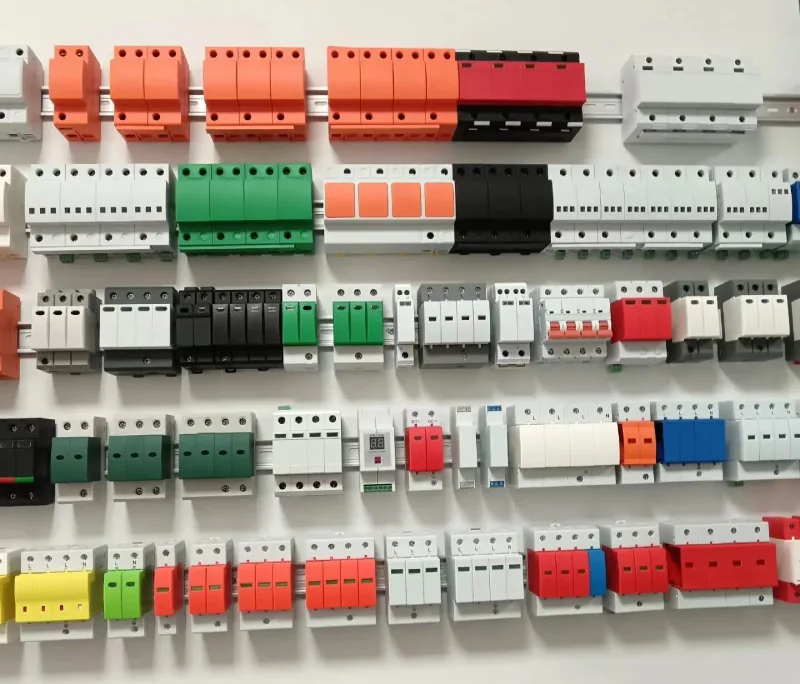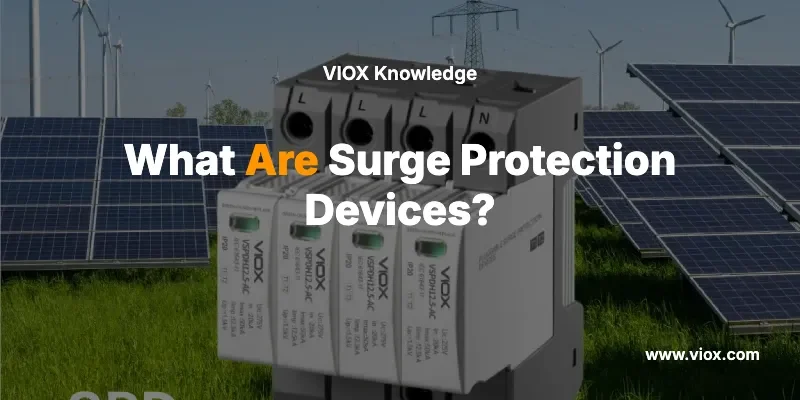Überspannungsschutzgeräte (SPDs) prevent electrical damage by redirecting excess voltage away from sensitive electronics, but they also introduce potential failure points and ongoing maintenance requirements. While SPDs can save thousands in equipment replacement costs, understanding their limitations is crucial for making informed electrical safety decisions.
Was sind Überspannungsschutzgeräte?

Surge protection devices are electrical components that detect voltage spikes and redirect excess electrical energy to ground, protecting connected equipment from damage. SPDs work by monitoring incoming voltage levels and activating within microseconds when voltage exceeds safe thresholds, typically 150V for 120V circuits.
Key SPD Classifications:
- Typ-1-EPPDs: Service entrance protection (utility-side)
- Typ-2-EPPDs: Distribution panel protection (most common residential)
- Typ-3-EPPDs: Point-of-use protection (individual outlets)
Surge Protection Devices: Complete Pros and Cons Comparison
| Vorteile | Benachteiligungen |
|---|---|
| Schutz der Ausrüstung: Prevents damage to electronics worth thousands of dollars | Begrenzte Lebensdauer: Components degrade with each surge event |
| Insurance Compliance: Required by many insurers for claims coverage | No 100% Guarantee: Cannot protect against all surge types |
| Einhaltung des Kodex: Required by NEC 2020+ for many installations | Maintenance Required: Regular testing and replacement needed |
| Multi-Level Protection: Can be installed at service entrance, panel, and outlet levels | Installationskosten: Professional installation ranges $200-$800+ |
| Fast Response Time: Activates within nanoseconds of voltage spike detection | False Security: May fail without visible indication |
| Garantieumfang: Many manufacturers offer connected equipment warranties | Ground Dependency: Requires proper grounding to function effectively |
| Noise Reduction: Filters electrical noise improving equipment performance | Temperatur-Empfindlichkeit: Extreme temperatures affect performance |
Professional Expert Tips
⚡ Safety Warning: Always have SPDs installed by licensed electricians. Improper installation can create fire hazards and void insurance coverage.
💡 Expertentipp: Install a three-tier protection system: Type 1 at service entrance, Type 2 at electrical panel, and Type 3 at sensitive equipment for maximum protection.
Detailed Advantages of Surge Protection Devices
Schutzwert der Ausrüstung
SPDs protect against voltage spikes that can instantly destroy electronics. A single lightning strike can generate over 100,000 volts, while most consumer electronics are designed for 120V operation. The average cost of replacing destroyed electronics ranges from $3,000-$15,000 per household, making SPD investment highly cost-effective.
Insurance and Code Compliance
Nationales Elektrogesetz (NEC) 2020 Article 230.67 requires surge protection for residential services in many jurisdictions. Insurance companies increasingly require SPDs for claims coverage, particularly in lightning-prone areas.
Multi-Level Protection Strategy
Professional installations use coordinated protection:
- Serviceeingangs-SPDs handle large utility surges
- Panel SPDs protect distribution circuits
- Point-of-Use-SPDs provide final protection for sensitive devices
Response Time Performance
Quality SPDs respond within 1-5 Nanosekunden, faster than equipment damage can occur. This rapid response is crucial since voltage spikes can damage semiconductor components in microseconds.
Critical Disadvantages and Limitations
Limited Lifespan and Degradation
SPDs sacrifice themselves to protect other equipment. Each surge event degrades internal components, eventually requiring replacement. Most residential SPDs need replacement every 5-10 years, sooner in high-surge environments.
⚠️ Safety Alert: Failed SPDs may not indicate failure visually. Regular testing with multimeters or indicator lights is essential.
No Absolute Protection Guarantee
SPDs cannot protect against all surge types:
- Direkte Blitzeinschläge may overwhelm protection
- Switching surges from large motors may exceed capacity
- Sustained overvoltage requires different protection methods
Installation and Maintenance Costs
Professional SPD installation costs:
- Whole-house panel SPDs: $300-$800 installed
- Serviceeingangs-SPDs: $500-$1,200 installed
- Annual inspection costs: $75-$150
Anwendungen und Anwendungsfälle

Anwendungen für Wohnzwecke
- Home theaters and entertainment systems
- Computer and networking equipment
- HVAC systems and appliances
- Smart home automation systems
Kommerzielle Anwendungen
- Rechenzentren und Serverräume
- Fertigungsanlagen
- Medical device protection
- Telekommunikationsinfrastruktur
High-Risk Environments Requiring SPDs
- Gebiete mit häufiger Blitzaktivität
- Locations near industrial facilities
- Buildings with overhead power lines
- Facilities with sensitive electronic equipment
SPD Selection Criteria and Specifications
| Spezifikation | Residential Standard | Commercial Standard | Critical Systems |
|---|---|---|---|
| Nennspannung | 150V (120V systems) | 320V (277V systems) | Custom engineered |
| Aktuelle Bewertung | 20kA minimum | 40kA minimum | 100kA+ |
| Reaktionszeit | <5 nanoseconds | <1 nanosecond | <1 nanosecond |
| MCOV Rating | 150V continuous | 320V continuous | System specific |
| UL Listing | UL 1449 Type 2 | UL 1449 Type 1/2 | UL 1449 + IEEE standards |
How to Choose the Right SPD
Step 1: Determine Protection Level Needed
- Assess equipment value and replacement costs
- Identify local surge risk factors (lightning frequency, power quality)
- Review insurance and code requirements
Step 2: Calculate Electrical System Requirements
- Measure service entrance amperage
- Identify panel configuration (single/three-phase)
- Verify grounding system adequacy
Step 3: Select Appropriate SPD Type
- Budget Option: Panel-mounted Type 2 SPDs ($150-$300)
- Standard Protection: Whole-house + point-of-use combination ($400-$800)
- Premium Protection: Three-tier coordinated system ($800-$1,500)
💡 Profi-Tipp: Always oversample SPD ratings by 25-50% to account for degradation over time and ensure adequate protection margins.
Installation Process and Requirements
Pre-Installation Assessment
- Electrical system evaluation by licensed electrician
- Grounding system verification (resistance <25 ohms)
- Panel space availability confirmation
- Local code compliance review
Professional Installation Steps
- Stromabschaltung and safety lockout procedures
- Mounting bracket installation in electrical panel
- Kabelverbindung following manufacturer specifications
- Grounding conductor installation (critical for operation)
- System testing and documentation
⚠️ Kritische Sicherheitswarnung: Never attempt DIY SPD installation. Electrical panel work requires professional expertise and may violate local codes and insurance policies.
Wartung und Fehlersuche
Regelmäßiger Wartungsplan
- Monatlich: Visual inspection of indicator lights
- Vierteljährlich: Voltage measurement verification
- Jährlich: Professionelle Elektroanlagenprüfung
- After major storms: Complete SPD function testing
Common SPD Problems and Solutions
| Problem | Symptome | Professional Solution |
|---|---|---|
| SPD Failure | No indicator light, equipment damage | Complete SPD replacement |
| Lästiges Auslösen | Häufige Auslösungen des Leistungsschalters | Check for oversized SPD, ground faults |
| Partial Protection | Some equipment affected | Verify proper wire sizing, connections |
| Erdschlussprobleme | SPD not functioning | Professional grounding system upgrade |
Wann Sie einen Fachmann anrufen sollten
Sofortige professionelle Hilfe erforderlich:
- Any electrical panel modifications
- Whole-house SPD installations
- After lightning strikes or major surges
- When SPD indicator lights show failure
- For insurance claim documentation
Certified electricians must:
- Verify proper grounding systems
- Ensure code compliance installation
- Provide proper documentation for insurance
- Calculate appropriate SPD ratings for your system
Häufig gestellte Fragen zu Überspannungsschutzgeräten
Do surge protectors really work for lightning protection?
SPDs provide significant protection but cannot guarantee 100% protection against direct lightning strikes. They excel at protecting against indirect strikes and utility system surges, which account for 80% of electrical damage incidents.
Wie lange halten Überspannungsschutzgeräte?
Whole-house SPDs typically last 5-10 years, depending on surge frequency and local electrical conditions. Point-of-use surge protectors may need replacement every 2-3 years in high-surge environments.
Can I install surge protection devices myself?
Panel-mounted SPDs require professional installation by licensed electricians. DIY installation violates most local electrical codes and can create serious safety hazards and insurance coverage issues.
What’s the difference between surge protectors and surge protection devices?
Surge protection devices (SPDs) are permanent electrical panel installations, while surge protectors are typically plug-in devices for individual outlets. SPDs provide whole-house protection with faster response times.
Do I need surge protection if I have GFCI outlets?
GFCI outlets protect against ground faults, not voltage surges. SPDs and GFCI protection serve different safety functions and both are recommended for comprehensive electrical protection.
How much does whole-house surge protection cost?
Professional installation of whole-house SPDs ranges from $300-$800, depending on panel configuration and local labor rates. This investment typically pays for itself by preventing a single major equipment loss.
Will surge protection devices reduce my electric bill?
SPDs may slightly reduce electrical noise, potentially improving appliance efficiency, but they are not primarily energy-saving devices. Their value lies in equipment protection rather than utility bill reduction.
Can surge protection devices fail without warning?
Yes, SPDs can fail silently without visible indicators. This is why regular professional testing and monitoring of indicator lights is essential for maintaining protection.
Making the Right Decision: SPD Investment Analysis
Rahmen der Kosten-Nutzen-Analyse
Protection Investment:
- Anfängliche Kosten: $300-$800 (professional installation)
- Wartung: $50-$100 annually
- Ersatz: Every 5-10 years
Potential Savings:
- Average electronics replacement: $3,000-$15,000
- HVAC system replacement: $5,000-$15,000
- Insurance deductible savings: $500-$2,500
- Business downtime prevention: Varies significantly
Faktoren zur Risikobewertung
High-risk situations requiring SPDs:
- Frequent thunderstorms (>30 days annually)
- Rural areas with overhead power lines
- Homes with extensive electronics and smart systems
- Buildings with inadequate grounding systems
- Areas with poor utility power quality
Conclusion and Professional Recommendations
Surge protection devices offer substantial benefits for equipment protection and code compliance, but require proper selection, professional installation, and ongoing maintenance to remain effective. The investment in quality SPDs typically pays for itself by preventing a single major equipment loss.
Professionelle Empfehlungen:
- Install three-tier protection for comprehensive coverage
- Use only UL-listed devices meeting current NEC standards
- Hire licensed electricians for all panel-level installations
- Implement regular maintenance schedules to ensure continued protection
- Document installations properly for insurance compliance
Fazit: SPDs are essential safety investments for modern homes and businesses, but success depends on proper system design, professional installation, and ongoing maintenance commitment.
For specific SPD recommendations and professional installation in your area, consult with licensed electrical contractors familiar with local codes and surge protection requirements. Always prioritize safety and code compliance over cost savings when protecting your electrical systems.
Verwandte Seiten
Was ist ein Überspannungsschutzgerät (SPD)
So wählen Sie das richtige SPD für Ihre Solarstromanlage
Wie sich Überspannungsschutzgeräte (SPDs) von anderen Überspannungsschutzmethoden unterscheiden


